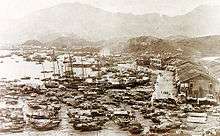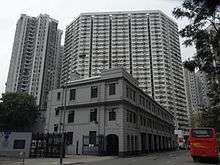Yau Ma Tei

| Yau Ma Tei | |||||||||||||||||
| Chinese | 油麻地 | ||||||||||||||||
|---|---|---|---|---|---|---|---|---|---|---|---|---|---|---|---|---|---|
| |||||||||||||||||
Yau Ma Tei, also known as Waterloo (see Name section), is an area in the Yau Tsim Mong District in the south of the Kowloon Peninsula in Hong Kong.
Name
Yau Ma Tei is a phonetic transliteration of the name 油麻地 (originally written as 油蔴地) in Cantonese. It can also be spelt as Yaumatei, Yau Ma Ti, Yaumati or Yau-ma-Tee.
Yau (油) literally means "oil", Ma (麻 or 蔴) can either refer to "sesame" or "jute", and Tei (地) means "field" or "open ground". Hence, Yau Ma Tei can be interpreted to mean either "oil-sesame field" or "oil and jute ground". This dual-interpretation is perhaps the reason why there are two explanations for the origin of the place name.[1]
The area is also named Waterloo in English, after Waterloo Road. This name was used for the MTR station in the area when it was opened in 1979.
Geography
Dundas Street marks the north border of Yau Ma Tei with Mong Kok and Austin Road its south border with Tsim Sha Tsui. To its west is Victoria Harbour and its east the hilly region of Ho Man Tin.
Southern Yau Ma Tei was traditionally known as Kwun Chung, but came to be called Jordan after the completion of Jordan MTR station at its heart.
History


Yau Ma Tei was a village in Kowloon. It was mentioned that a Chinese burial ground was assigned at a mile northeast of a village of Yau-ma-Tee at 2 December 1871.[2]
The name Yau Ma Tei is not thought to pre-date British rule. However, Kwun Chung is mentioned in many historic documents. Kwun Chung was a river valley with village and cultivation. On the hill south near the coast was Kwun Chung Fort built by Chinese (Qing) official Lin Tse-hsu to defend against the British. During the Battle of Kwun Chung in 1839, the fort — together with Tsim Sha Tsui Fort — successfully kept the British from Kowloon. The fort with the hill was demolished for development during early British rule of Kowloon.
Before the ceding of Kowloon to the British in 1860, Yau Ma Tei was a beach and a bay gathering many Tanka fishermen. Its water remains a harbour for fishermen after several times of reclamation by the Hong Kong Government. The Yau Ma Tei Typhoon Shelter became an exotic water area where restaurants on boats offered dishes of indigenous seafood. These 'typhoon shelter dishes' remain famous to this day and are even offered on land. The typhoon shelter not only hosted fishermen, but was also a port in Hong Kong. Numerous piers were built along its shore.
Ferry Point in the southern part of Yau Ma Tei was a transportation hub where many commuters took ferries to and from Hong Kong Island. The service was offered by Hongkong and Yaumati Ferry.
Inland, the reclamation became the residential area for the ever-increasing Chinese population, with retail shops on the street level. Shanghai Street was the main street before being replaced by Nathan Road.
Along Waterloo Road is the century-old Fruit Market; its adjacent Yaumati Theatre was once the largest in Kowloon. The Kwong Wah Hospital was the first hospital on the Kowloon peninsula, established in 1911. YMCA headquarters and its hostel in Hong Kong are located on the road.
Public health
Kwong Wah Hospital, run by charity Tung Wah Group of Hospitals, is the first major hospital in the area. Historically, there was a small pox hospital (油蔴地痘局) at the hill northeast of Kwong Wah Hospital. Founded by Hong Kong Government, Queen Elizabeth Hospital is another major hospital in the area.
Sightseeing

The district is mainly an area of mixed residential and retail. During day time, the Yau Ma Tei wet market and fruit market are the markets to visit, buying souvenirs like dried noodles and some fruits. Every night there is a market selling many different kinds of products including clothes, decorations, VCD and toys in Temple Street, a street in the area where the famous Tin Hau Temple was built in 1876. The Temple is at Public Square Street. The square, known as Yung Shue Tau, was a night market.
Museums
The Hong Kong International Hobby and Toy Museum (香港國際玩具博物館), located at No. 330 Shanghai Street, showcases models, toys and pop culture memorabilia from around the world. Exhibits include toy vehicles, dolls, action figures, cartoon characters, science fiction collectibles, model rockets, Japanese anime, classic toys.[3]
Tung Wah Group of Hospitals Museum in Kwong Wah Hospital details the history of Tung Wah Group of Hospitals and its relation with Hong Kong people, is also located in Yau Ma Tei.
Historic buildings
- Tin Hau Temple (天后廟)
- Yau Ma Tei Police Station
- Yau Ma Tei Fruit Market
- Yaumati Theatre
- Engineer's Office of the Former Pumping Station
- Old South Kowloon District Court
- Kowloon Union Church
Public housing

Prosperous Garden
In the 1980s, the Government handed over the redevelopment project of Lee Tat Street (Chinese: 利達街) and Cheung Shui Street (Chinese: 祥瑞街) in Yau Mei Tei (the two streets were later removed during redevelopment) to the Hong Kong Housing Society. This became Prosperous Garden (Chinese: 駿發花園), a "Urban Improvement Scheme" estate[4] in Public Square Street[5] Phase 1, including Block 1, 2 and 5, was completed in the site in 1991. Block 1 and 2 were for sale while Block 5 was for rental. Its Phase 2, including Block 3 and 4, was completed in 1995 and was for sale.[6]
Hoi Fu Court
Hoi Fu Court (Chinese: 海富苑) is a mixed Home Ownership Scheme court and public estate built on reclaimed land of the old Yau Ma Tei Typhoon Shelter.[7][8] It is the only public housing estate built by Hong Kong Housing Authority in the District. It comprises 6 blocks completed in 1999 and 2004.[9][10]
Charming Garden
Charming Garden is an 18-block estate built under the Home Ownership Scheme and Private Sector Participation Scheme.
Education
The Wah Yan College, Kowloon is located in Yau Ma Tei and is a boys' school. True Light Girls' College, which is a girls' EMI school, is adjacent to Wah Yan College. The Methodist College is located in Yau Ma Tei. It's an EMI school for both boys and girls.
Transport
Nathan Road goes north-south across the heart of Yau Ma Tei. Most of buses routes via Nathan Road to the destinations in North Kowloon and New Territories. Trains of MTR shuttle beneath the road. Yau Ma Tei is served by Tsuen Wan and Kwun Tong lines on the MTR metro system, at a single station with the same name, Yau Ma Tei MTR Station. The station is the terminus of Kwun Tong Line.
Other streets in the area or partly in the area include:
See also
- List of areas of Hong Kong
- Broadway Cinematheque
- Eaton Hotel Hong Kong
- Fo Pang
- King's Park, Hong Kong
- Kowloon Central Post Office
- Yaumatei Ferry Pier
References
- ↑ Architectural Conservation Office, HKSAR Government. (2008). Heritage Impact Assessment Report of the Yau Ma Tei Theatre & Red Brick Building Retrieved October 21, 2009
- ↑ Hongkong Government Gazette, Notification 169 of 2 December 1871
- ↑ Official website of the Hong Kong International Hobby and Toy Museum
- ↑ Urban Redevelopment Project (Chinese)
- ↑ Location with Reverse Vending Machine Installed
- ↑ Prosperous Garden (Chinese)
- ↑ TYPHOON SHELTER
- ↑ Hoi Fu Shopping Centre, Mongkok
- ↑ Hong Kong Housing Authority: Hoi Fu Court
- ↑ Yu, Pui-kwan, Robin, "A study on quasi-public space in large scale private residential development, case in Hong Kong", University of Hong Kong, 2007
External links
| Wikimedia Commons has media related to Yau Ma Tei. |
- History of Yau Ma Tei (pp. 5–12)
Coordinates: 22°18′47″N 114°10′14″E / 22.31301°N 114.17053°E